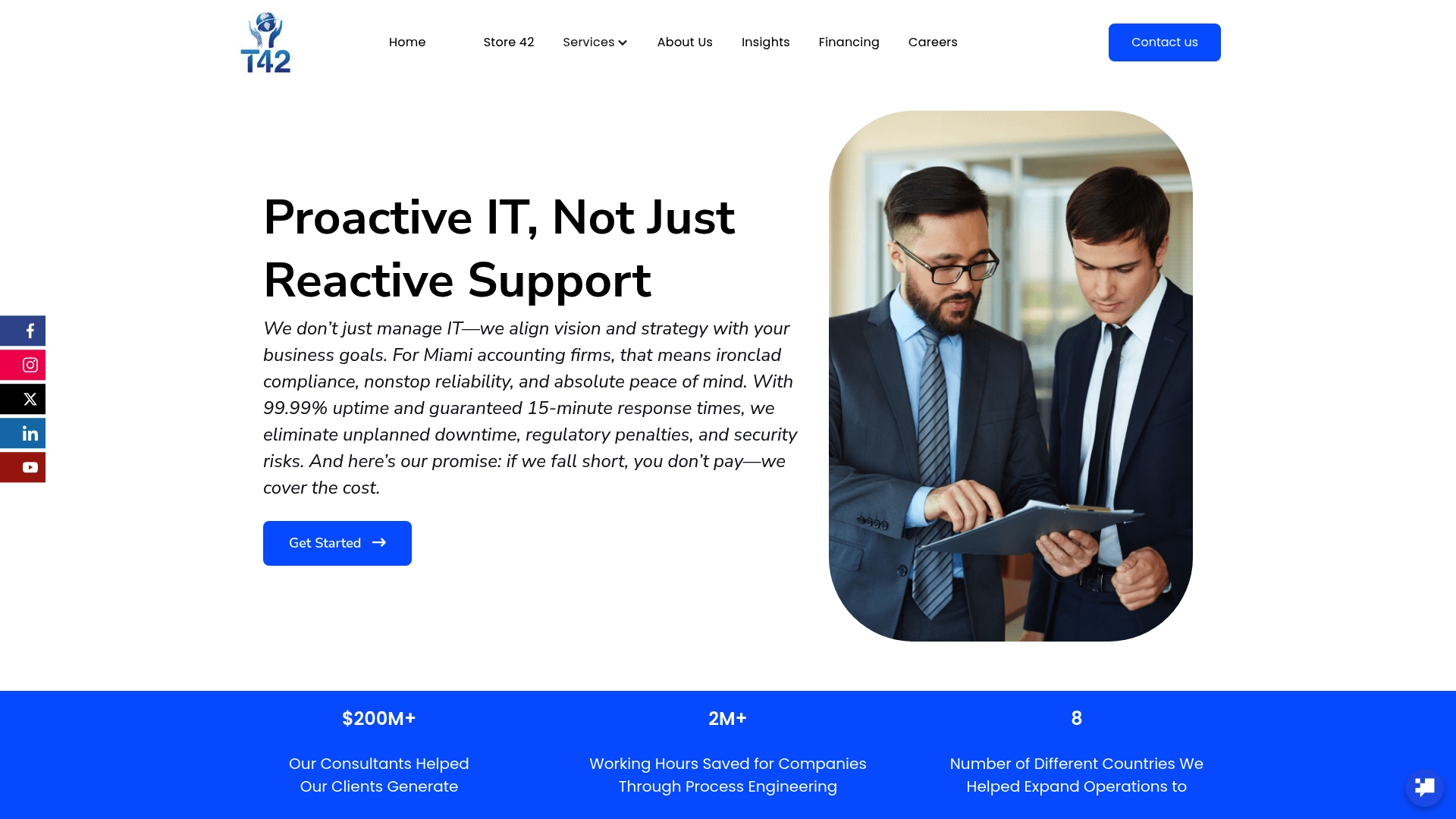
Over 60 percent of accounting firms report at least one cyber incident each year, highlighting how crucial strong IT management has become in financial services. Miami firms face unique challenges as they juggle local regulations, strict compliance standards, and fast-changing technology. Understanding how to assess, secure, and continually improve your digital systems can mean the difference between smooth operations and costly disruptions.
| Key Point | Explanation |
|---|---|
| 1. Conduct Comprehensive IT Audits | Assess all hardware and software in your practice to identify vulnerabilities and compliance status with industry standards. |
| 2. Set Clear IT Objectives | Align technology goals with firm strategy using the SMART framework to enhance performance and security specific to your services. |
| 3. Implement Robust Security Protocols | Establish multilayered security measures including employee training and incident response plans to safeguard client data. |
| 4. Monitor Performance Regularly | Implement key performance indicators to ensure ongoing compliance, operational efficiency, and quick identification of potential issues. |
| 5. Adapt IT Management Strategies | Regularly review and adjust your IT strategies based on team feedback and performance metrics to keep pace with evolving needs. |
If you run an accounting firm in Miami, your IT infrastructure is your financial lifeline. This step helps you understand exactly where your technology stands and what risks might be hiding in plain sight.
Start by conducting a comprehensive technology audit that maps out every single digital touchpoint in your practice. Walk through your entire network like a detective tracking clues. Check your hardware systems computer by computer. Look at each workstation running your tax preparation software. Review your servers handling sensitive client financial records. Examine your network switches and routers that connect your team.
According to our essential guide to managed IT services, understanding your current infrastructure means going beyond basic inventory. You need to assess performance metrics system reliability and potential vulnerabilities.
For accounting firms especially compliance is king. According to the Institute of Internal Auditors Global Technology Audit Guide tracking regulatory requirements is crucial. Your audit should specifically highlight how your current systems meet IRS data protection standards healthcare privacy regulations like HIPAA if you have medical clients and financial industry cybersecurity mandates.
Pro Tip: Do not attempt this audit alone. Consider bringing in an external IT professional who understands Miami accounting firm specific technology needs.
Your goal is creating a crystal clear snapshot of your technology landscape identifying weak spots before they become expensive problems. Document everything meticulously network diagrams current software versions access controls backup systems disaster recovery protocols.

What comes next? We will transform this raw assessment into a strategic technology roadmap that protects your practice and positions you for growth.
Successful IT management for your Miami accounting firm starts with crystal clear objectives that directly support your business goals. Think of these objectives as a roadmap that connects technology to your practice’s financial and strategic vision.
Begin by understanding what makes your accounting firm unique. Are you a boutique tax preparation service catering to small businesses in Little Havana? A multi partner firm serving international clients across Latin America? Your IT objectives must reflect your specific practice model.
According to our guide on understanding IT service management, creating meaningful IT objectives requires a deep dive into your firm’s operational needs. This means looking beyond generic tech goals and focusing on outcomes that drive your business forward.
Research from Accounting Insights suggests using SMART framework for objective setting specific measurable achievable relevant and time bound goals. For a Miami accounting firm this might look like reducing client data processing time by 40% within six months or implementing a cybersecurity protocol that meets Florida financial regulations within one quarter.
Pro Tip: Your IT objectives should directly translate technical capabilities into business advantages that your clients can understand and appreciate.
Break down your objectives into three key categories performance security and growth.
What happens next? You’ll transform these objectives into a strategic implementation plan that turns technology from a cost center into a competitive advantage for your accounting practice.
Protecting your accounting firm’s digital infrastructure is not just about technology its about safeguarding your clients financial futures. This step will help you build an ironclad security framework that keeps sensitive data locked down tight.
Start by understanding your unique risk landscape. Miami accounting firms handle incredibly sensitive financial information which makes you prime targets for cybercriminals. According to the FDIC cybersecurity framework protecting financial institutions requires a multilayered approach that goes far beyond basic antivirus software.
Our comprehensive IT strategy guide emphasizes that security protocols must be comprehensive systematic and continuously evolving. This means implementing robust measures across every single digital touchpoint in your practice.
Your security strategy should include several critical components network protection endpoint security employee training and incident response planning. For network protection invest in enterprise grade firewalls and intrusion detection systems. Endpoint security means installing advanced antimalware solutions on every single computer tablet and mobile device used in your firm.
Pro Tip: Conduct quarterly security training for your entire team. Human error remains the biggest vulnerability in any technology system.
According to Accounting Insights modern accounting firms need integrated security approaches that combine cloud technologies robust infrastructure and proactive monitoring. This means working with IT professionals who understand the specific compliance requirements of financial services in Florida.
Establish clear protocols for data access encryption password management and remote work security. Create tiered access levels that limit sensitive information to only those who absolutely require it. Implement multi factor authentication across all critical systems.
What comes next? You will develop a comprehensive disaster recovery and business continuity plan that ensures your firm can withstand any technological challenge while keeping client data completely secure.
Now that youve established your IT infrastructure its time to transform from setup mode to continuous improvement. Think of this step as your technology health check a systematic approach to keeping your accounting firms digital systems running smoothly and legally.
The Public Company Accounting Oversight Board provides critical guidance for maintaining professional standards. As the PCAOB outlines monitoring performance isnt just about tracking numbers its about creating a comprehensive quality control system that protects your firms reputation and client trust.
Our understanding of IT service management emphasizes the importance of regular performance assessments. This means implementing tools and processes that provide real time insights into your technology ecosystem.
Start with establishing key performance indicators specific to accounting firms. These might include system response times data processing speed security breach attempts client data access logs and compliance verification metrics. Track these metrics monthly and look for trends that could indicate potential issues before they become serious problems.
Pro Tip: Dont just collect data analyze it. Numbers without context are just noise.
According to Accounting Insights effective IT auditing requires a proactive approach to risk management. This means developing a systematic process for continuous evaluation. Schedule quarterly comprehensive reviews that examine every aspect of your technology infrastructure.
Focus on three critical compliance areas regulatory adherence operational efficiency and security protocols. For Miami accounting firms this means staying current with Florida financial regulations IRS data protection standards and industry specific cybersecurity requirements.
What comes next? You will develop a dynamic technology adaptation strategy that turns monitoring from a routine task into a strategic advantage for your accounting practice.
Youve built your IT infrastructure implemented security protocols and established monitoring systems. Now its time to step back and evaluate how everything is actually working for your accounting practice.
The Pennsylvania Institute of Certified Public Accountants emphasizes that digital transformation is not a one time event but an ongoing process of continuous improvement. This means regularly examining your technology performance and being willing to make strategic adjustments.
Our guide on building an IT strategy highlights the critical importance of adaptability in technology management. For Miami accounting firms this means creating a flexible framework that can quickly respond to changing business needs and technological advances.
Start by conducting a comprehensive performance review. Compare your current IT systems against the original objectives you set. Are you achieving the performance metrics you established? Are there unexpected bottlenecks or inefficiencies emerging? Look beyond simple numbers and consider how technology is actually supporting your firms workflow and client service delivery.
Pro Tip: Technology should make your work easier not more complicated. If a system is creating more problems than it solves its time to reconsider.
According to Accounting Insights modern accounting firms need adaptive IT support strategies that can quickly pivot based on real world performance data. This means being proactive about identifying potential improvements not just waiting for systems to fail.
Develop a quarterly review process that includes input from your entire team. Your staff often have the most practical insights about what is working and what needs improvement. Create a collaborative environment where technology recommendations can come from anyone in the organization.
What comes next? You will transform your IT management from a static infrastructure into a dynamic strategic asset that continuously evolves to support your accounting firms growth and success.
Here’s a summary of the key objectives and focus areas for each IT management step:
| Step | Primary Objective | Focus Areas |
|---|---|---|
| 1: Assess Infrastructure | Map technology landscape | Audit hardware Review software Track compliance |
| 2: Set IT Objectives | Align tech with firm goals | Performance Security Growth targets |
| 3: Security Protocols | Protect data & systems | Network security Employee training Incident response |
| 4: Monitor & Maintain | Continuous improvement | Performance metrics Compliance reviews Risk management |
| 5: Review & Adjust | Refine strategies | Performance reviews Team feedback Adaptation plans |
Managing IT services for Miami accounting firms means overcoming complex challenges like meeting strict compliance standards and ensuring nonstop system reliability. From implementing ironclad security protocols to monitoring performance and adapting strategies, every detail matters when your clients depend on you for financial accuracy and privacy. If you want to stop worrying about unplanned downtime, regulatory penalties, or security risks, you need a partner that aligns IT strategy directly with your firm’s goals.

Take control of your technology landscape today and experience 99.99% uptime with guaranteed 15-minute response times. Visit https://www.transform42inc.com/ to see how we transform IT management into a competitive advantage for Miami accounting firms. Don’t wait until an IT failure disrupts your practice. Get peace of mind now by learning more on our IT strategy guide and essential managed IT services pages. Your clients’ financial futures depend on the right technology partner.
Start by conducting a comprehensive technology audit that maps out all digital touchpoints in your practice. Document your hardware, software, network systems, and compliance with relevant regulations to identify weak spots.
Focus on setting clear objectives that align with your firm’s goals, like improving system uptime, enhancing data security, and supporting growth strategies. Break these down into specific, measurable goals to track progress effectively.
Develop a comprehensive security framework that includes network protection, employee training, and incident response planning. Start by investing in enterprise-grade firewalls and establishing quarterly security training for your team to minimize human error.
Establish key performance indicators such as system response times, data processing speeds, and compliance verification metrics. Monitor these metrics monthly to identify trends and adjust your strategy as needed to optimize performance.
Conduct a comprehensive performance review at least quarterly to assess how well your IT systems are meeting your objectives. Use feedback from your team to identify areas for improvement and adapt your technology strategy accordingly.
Re-evaluate your current technology systems and processes to identify bottlenecks or issues. Collaborate with your team to gather insights and explore alternatives that can simplify operations and enhance your firm’s productivity.